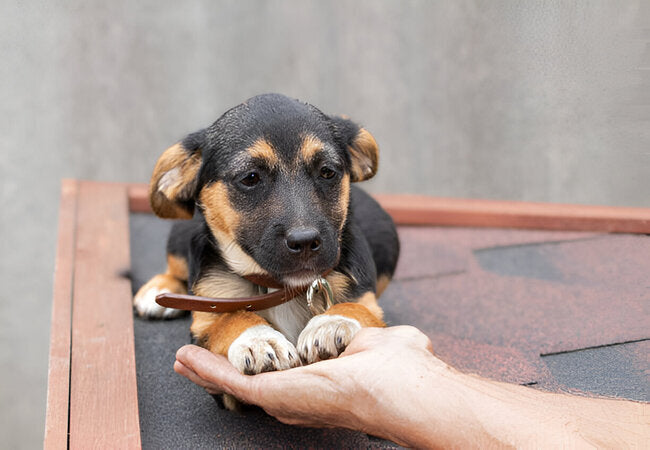Why Dogs Put Their Paws on People in 2025 – Vet‑Approved Signals & Advice 🐶✋

In this article
Why Dogs Put Their Paws on People in 2025 – Vet‑Approved Signals & Advice 🐶
By Dr. Duncan Houston BVSc
When your dog reaches out with a paw on your lap, arm, or face, it's rarely random. This behavior is layered with meaning—affection, communication, anxiety, requests, or calming signals. In this vet-reviewed 2025 guide, you'll learn when pawing is sweet, when it's serious, and how to respond in ways that deepen understanding and trust. Let's decode those gentle taps! 🧠🐾
1. Pawing as Communication
The American Kennel Club notes, dogs use their paws much like we use hands—“to mean, ‘I have a need, such as I need to go outside or I am hungry’”. It's a direct, effective form of communication—usually clarified by context.
2. Affection & Bonding
Pawing can be a canine “hug” or handshake. As Rebecca Forrest from The Dog Clinic explains, it "is a sign of affection, closeness and trust"—“petting you back,” essentially. It's a warm gesture of companionship and mutual comfort.
3. To Get Your Attention
Sometimes, the paw comes with subtle urgency: “Hey, look at me!” Whether it’s mealtime, a walk, play, or a scratch beneath the chin, your dog’s paw is often a gentle nudge for interaction.
4. Comfort-Seeking or Anxiety
Pawing may indicate stress or insecurity. Dogs use this gesture as a calming or appeasement signal, especially complemented by other body language such as lip licking, yawning, or tucked ears. If your dog’s nervous—during storms, vet visits, or transitions—they might paw you for reassurance.
5. Requesting Space or “Enough”
Paws aren’t always affectionate. Trupanion explains that a dog may paw to stop discomfort, say, if they're tired of your touch or feel crowded. It's polite canine body language meaning “Please back up.”
6. Self-Soothing Behavior
Similar to a child playing with their hair, some dogs paw to calm themselves in stressful settings, like at the vet, as one Reddit owner shared: their senior Aussie would paw for reassurance during anxiety-inducing situations.
7. Play Initiation
Puppies often paw at humans to initiate play, usually paired with mouthing, jumping, or play bows. It's an invitation to engage, bounding off from youthful energy and instinctive gestures.
8. Context & Body Language Matter
To interpret pawing effectively, look for cues:
- Relaxed body, soft eyes: affectionate pawing.
- Added whining/gaze shift: request for attention, food, or the outdoors.
- Tense posture, ears back: anxiety-related pawing, offering comfort.
- Paw plus backing off: “Space, please.”.
- Playful stance: front leg up, wagging tail—game on!.
🧭 Responding Appropriately
- If affectionate, enjoy it—gentle pets reinforce bonding.
- If attention-seeking: pause to consider their need—a quick check-in, walk, or treat.
- If anxious: offer comfort, calm words, but avoid reinforcing fear. Cue a relaxing activity.
- If requesting space, respect it—allow them physical or emotional breathing room.
- If it's play invitation: engage in brief structured play or teach an “ask” cue like “paw”.
🚨 When to Monitor or Redirect
Be aware if pawing becomes compulsive or intrusive—if your dog constantly taps for attention or during serious anxiety, it may benefit from a structured plan involving enrichment, calm routines, or vet/behaviorist support.
📋 Quick Reference Table
| Context | Body Language | Likely Reason | Appropriate Response |
|---|---|---|---|
| Petting, soft eyes | Relaxed posture | Affection | Enjoy & reciprocate |
| Near the bowl/door, intently gazing | Whining, focused stare | Request (food/toilet) | Check & respond accordingly |
| During stress | Ears back, tense body | Comfort-seeking | Calm reassurance |
| You’re too close | Backing off, light paw | Claiming space | Give them room |
| Playful context | Play bow, wagging tail | Invite to play | Engage briefly |
📱 Ask A Vet App 2025 Support
Use the Ask A Vet app to:
- Upload a video of pawing behavior to identify context and need.
- Receive custom training/redirection tips for excessive pawing.
- Get guidance for handling anxiety-linked pawing or space cues.
Expert help ensures your dog’s pawing feels like a welcome conversation. 🐾📲
❤️ Final Thoughts
Those gentle dog paws on your leg? Their communication—simple or complex, affectionate or urgent. With a little attention to body language and context, you can respond with empathy, strengthen trust, and nurture a deeper bond. Here's to reading the paw‑grams from your pup! 🐶💬
Need tailored insight? Visit AskAVet.com or download the Ask A Vet app for personalized behavior support anytime.






